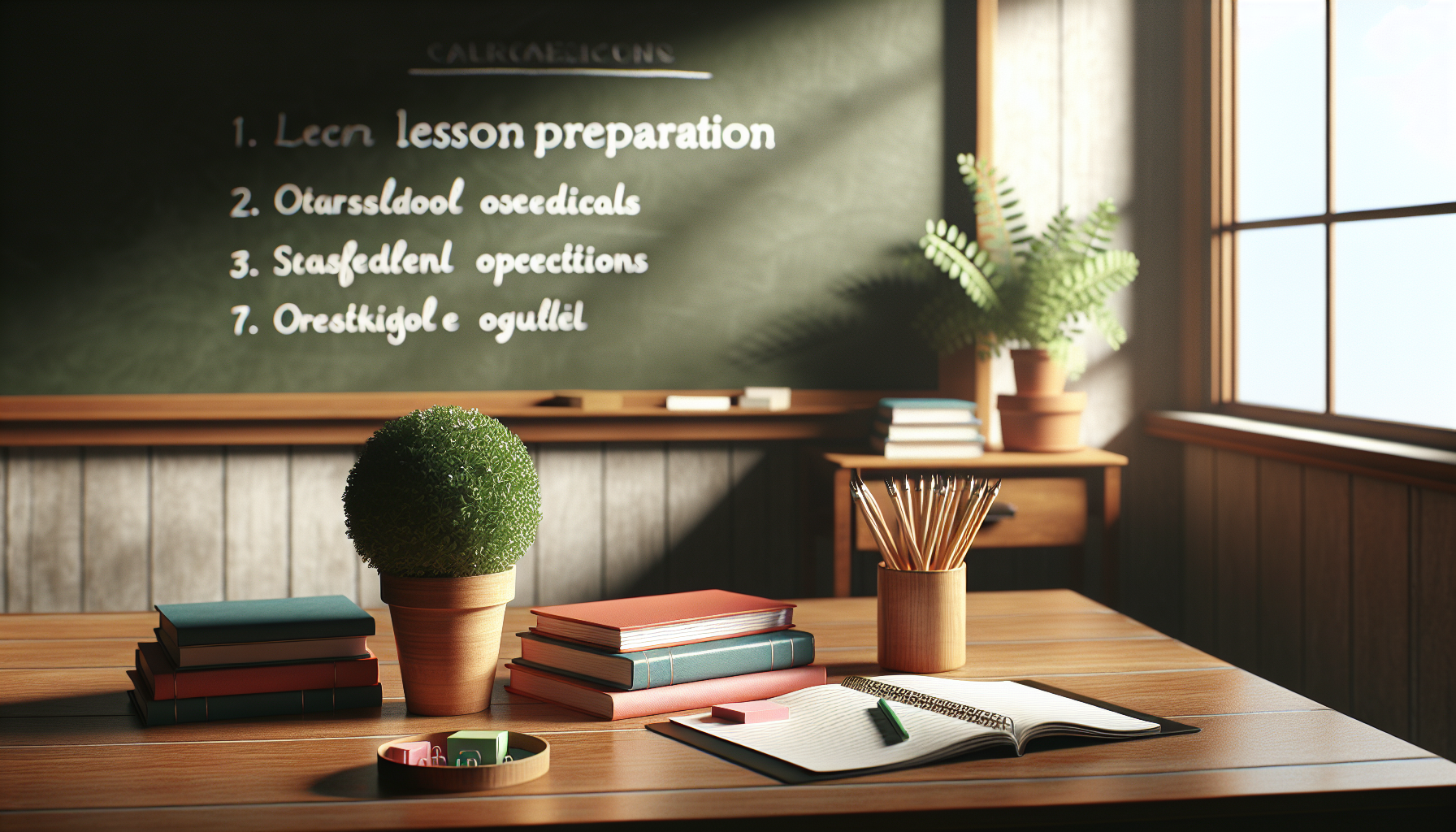What is Lesson Preparation?
So, let’s be honest: preparing for a lesson can feel like a daunting task. You might be wondering how to keep your students engaged or what materials you’ll even need. It’s completely normal to feel overwhelmed when facing a classroom full of eager minds.
But don’t worry! Stick around, and I promise you’ll discover some effective strategies that will turn lesson preparation from a stress fest into a breeze. With the right approach, you’ll be ready to conquer your classroom with confidence.
From understanding what lesson preparation really means to exploring its key elements and benefits, let’s dive into the essential steps that will make your teaching journey a lot smoother!
Key Takeaways
- Lesson preparation is about organizing content, objectives, and structure before teaching.
- Effective preparation boosts teacher confidence and improves classroom management.
- Well-prepared lessons enhance student engagement and understanding, making learning relevant.
- Clear objectives using SMART criteria help keep lessons focused and goals clear.
- Gather and organize all necessary materials in advance for a smooth lesson delivery.
- Diverse teaching methods, like active learning, encourage participation and deeper understanding.
- Time management is crucial; plan segments and be flexible based on student needs.
- Knowing your audience’s learning preferences allows for tailored lesson plans.
- Include both formative and summative assessments to measure student learning effectively.

Definition of Lesson Preparation
Lesson preparation is the process of outlining and organizing the content, objectives, and structure of a lesson before it’s delivered.
Essentially, it’s about creating a roadmap that guides both teaching and learning.
This framework for teaching ensures that educational objectives are met systematically while adapting to student needs.
When done right, lesson design can help teachers provide a coherent, engaging, and effective learning experience.
Importance of Lesson Preparation
Lesson preparation plays a crucial role in the educational process.
It sets the foundation for effective teaching techniques and directly impacts student engagement.
Without proper lesson planning, the chance for a structured and smooth delivery diminishes significantly, which can lead to confusion for students.
A well-prepared lesson can motivate students and help them relate to the content, making it relevant and applicable to their lives.
Benefits for Teachers
For teachers, the advantages of lesson planning are numerous.
One major benefit is increased confidence in teaching.
Knowing exactly what to cover allows teachers to focus on delivering content effectively rather than scrambling for materials or structure during the lesson.
Additionally, effective lesson planning leads to improved classroom management, as it helps set clear expectations for both the teacher and the students.
Moreover, it represents a solid foundation for professional development, allowing teachers to hone their instructional effectiveness over time.
Benefits for Students
Students also gain a lot from well-prepared lessons.
A structured lesson leads to enhanced understanding of the material being taught.
When lessons are tailored to meet specific learning outcomes, students are more likely to engage actively with the content.
Such planned learning experiences help in cultivating critical thinking and analytical skills.
By incorporating active learning strategies, students not only absorb information but also learn to apply it in real-world contexts, setting the stage for lifelong learning.

Key Elements of Lesson Preparation
When it comes to lesson preparation, certain elements are key to ensuring a smooth and effective learning experience.
By focusing on these elements, you can construct lessons that meet educational objectives while engaging your students.
Objectives and Goals
Establishing clear objectives and goals is the backbone of any successful lesson.
Use the SMART criteria – specific, measurable, achievable, relevant, and time-bound – to define outcomes.
For instance, instead of saying “students will understand photosynthesis,” specify “students will be able to explain the process of photosynthesis in their own words by the end of the lesson.”
This clarity helps students grasp what they are working toward and gives teachers a clear direction.
Setting these goals enhances students’ focus and keeps lessons on track.
Materials Needed
Having the right materials can make the difference between an engaging lesson and one that falls flat.
Begin by listing all the resources and materials you will need for the lesson.
This might include textbooks, videos, interactive tools, or even simple classroom supplies like whiteboards and markers.
Don’t forget about digital tools; platforms like Canva or Kahoot! can enhance presentations and promote interactivity.
Organizing materials in advance can save precious time during the lesson.
Teaching Methods and Strategies
The teaching methods you use can greatly impact the effectiveness of the lesson.
Consider incorporating a variety of pedagogical approaches, such as direct instruction, group work, and inquiry-based learning.
Differentiated instruction might be necessary to cater to different learning styles within your classroom.
Active learning strategies, like think-pair-share or role-playing, can encourage participation and deepen understanding.
For example, if you were teaching a history lesson, you could have students engage in a debate about a historical event.
This collaboration not only makes learning enjoyable but also helps students retain information better.
Time Management
Good time management can make or break a lesson.
Before your lesson, estimate how much time each segment will take and practice pacing your delivery.
It’s essential to build in time for student questions and discussions as well.
Use a timer or anchor points during the lesson to keep yourself and your students on track.
For instance, you might allocate 10 minutes for initial instruction, 15 minutes for group discussions, and 5 minutes for wrapping up the lesson.
Flexibility is key; be prepared to adjust your schedule based on student engagement or comprehension levels.
Steps in Lesson Preparation
Crafting a lesson involves a systematic approach that ensures clarity and effectiveness.
Here’s a step-by-step breakdown to help simplify the process.
Knowing Your Audience
Understanding your audience is the first critical step in lesson preparation.
Take time to analyze your student’s demographics, interests, and learning styles.
This knowledge allows you to tailor your lessons to meet their needs better.
For example, if your students are predominantly visual learners, incorporating videos or infographics can enhance their understanding.
Engage with them to gather feedback about their learning preferences; this two-way communication cultivates a more tailored teaching approach.
Planning the Lesson Structure
A well-structured lesson keeps both the teacher and students on track.
Start by creating an outline that includes an introduction, the body of the lesson, and a conclusion.
Consider varying the types of learning activities you include, such as group work, individual assignments, or discussions.
Organizing content logically helps ensure that concepts build on one another.
Always remember to include brief summaries after key points to reinforce understanding.
Creating Assessments and Evaluations
Assessments are essential to determine if students have met your learning objectives.
Incorporate both formative and summative assessments into your lesson plan.
For formative assessments, think of quick quizzes, polls, or in-class discussions to gauge understanding throughout the lesson.
As for summative assessments, consider projects or tests at the end of a unit, which measure overall knowledge comprehension.
Always provide feedback to encourage improvement and further learning.
For instance, you could create a Google Form quiz that gives instant results, helping both you and your students visualize learning outcomes.
These assessments not only inform teaching but also motivate students by showing progress.

Common Challenges in Lesson Preparation
Even the best lesson plans can face hurdles that make preparation a bit more complicated.
Recognizing and understanding these challenges can help you adapt and find solutions to keep your lessons effective.
Time Constraints
One major challenge in lesson preparation is time constraints.
Teachers often juggle numerous responsibilities, from grading to administrative tasks.
This leaves limited time for thorough lesson planning.
To combat this, try setting aside specific planning time each week and stick to it.
Even short, focused sessions can produce effective plans when you prioritize the most essential elements.
Also, consider reusing and adapting previous lesson plans to fit new topics, which can save valuable time.
Resource Limitations
Another challenge is dealing with resource limitations.
Sometimes, schools may not have access to the latest technology or adequate supplies.
In such cases, think creatively about alternative resources.
For instance, if you’re short on textbooks, look for free online resources or educational websites that can provide the needed materials.
Utilizing community resources, like local libraries or museums, can also fill gaps in materials.
Collaboration with colleagues can lead to shared resources, which minimizes individual constraints.
Tips for Effective Lesson Preparation
Preparation doesn’t have to be stressful if you employ some useful tips to streamline the process.
These simple strategies can lead to powerful improvements in your lesson planning routine.
Utilizing Technology
Using technology in lesson preparation can greatly enhance both teaching and learning experiences.
Explore digital platforms that offer lesson planning tools and resources.
For instance, applications like Edmodo can help manage class communications.
More interactive tools, like Kahoot! for quizzes and Puppetools for brainstorming, can engage students meaningfully.
Don’t forget about virtual whiteboards, which allow for collaboration during lessons.
Collaboration with Colleagues
Collaborating with colleagues can lighten the load and inspire fresh ideas.
Consider forming a team within your department to share lesson plans and strategies.
Peer feedback can provide valuable insights that you might overlook on your own.
Participating in professional learning communities (PLCs) can foster an exchange of innovative techniques.
Interdisciplinary planning can spark exciting connections between different subjects and broaden students’ learning experiences.
Conclusion on Lesson Preparation
In the grand scheme of education, lesson preparation is key to delivering effective and engaging learning experiences.
By understanding its importance and applying solid strategies, both teachers and students can reap significant benefits.
Whether it’s overcoming challenges or utilizing available resources wisely, preparation can pave the way for successful outcomes.
Remember, the goal is to create a dynamic learning environment that inspires students while making your teaching journey fulfilling.
So, grab those lesson plans and give your students the enriching experiences they deserve!
FAQs
Lesson preparation involves planning and organizing instructional materials and activities to create an effective teaching environment, ensuring both teachers and students are prepared for successful learning experiences.
Lesson preparation is crucial as it enhances teacher confidence, promotes student engagement, and ensures structured learning. Thorough preparation leads to better educational outcomes and effective classroom management.
Common challenges include time constraints for planning and limitations in available resources. These factors can hinder effective lesson preparation and impact teaching quality.
To enhance lesson preparation, utilize technology for resources and collaborative tools. Engaging with colleagues for ideas and feedback can also lead to improved lesson efficacy.
